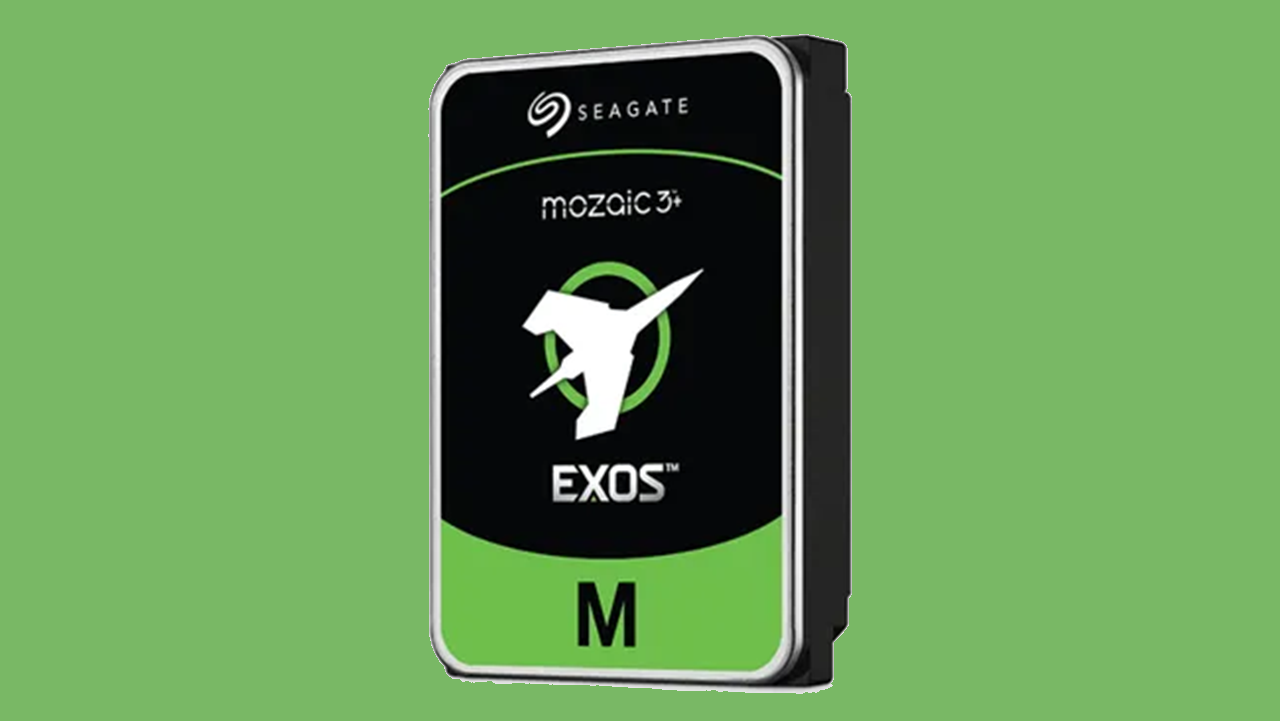Seagate launches 32TB Exos M hard drive based on HAMR technology – Mozaic 3+ drives are the world’s first generally available HAMR HDDs

Seagate’s biggest-ever hard drive is finally here, coming with 32TB of capacity courtesy of the company’s new HAMR technology (via Expreview).
It has almost been a year since Seagate said it had finally made a hard drive based on heat-assisted magnetic recording (HAMR) technology using its new Mozaic 3+ platform. A HAMR HDD has long been anticipated since Seagate started experimenting with the technology in 2007. For over a decade, Seagate has predicted HAMR-based drives would be released within years, but these predictions fell apart year after year until now.
Exos drives based on Mozaic 3+ were initially released to select customers in small quantities, but now the general release is (nearly) here, thanks to mass production. Coinciding with this, Seagate silently published the product page for its Exos M HDDs, which includes a 32TB model using the shingled magnetic recording (SMR) storage format and a 30TB model using conventional magnetic recording (CMR).
There seems to be a little confusion at Seagate whether its HDD is the Exos M or Exos M 3+. The product page simply calls it the Exos M and a video published by Seagate’s official YouTube channel also says Exos M, but the URL says “exos-m-3-plus,” and the video title mentions the Exos M 3+. We’ve reached out to Seagate to clarify the naming situation.
Unlike the first Mozaic 3+ HDDs, Exos M drives are compatible with existing computers, which is pretty important to achieve mass adoption. Requiring new hardware to use the new HAMR hard drives would obviously be a significant obstacle and downside to upgrading. Whether that means Exos M is substantially different under the hood from the original Mozaic 3+ drives is unclear at the moment, though; the product page doesn’t offer very many details in that regard.
Seagate’s main competition in high-capacity HDDs at the moment is Western Digital, which launched ePMR-based drives in October, which included a 32TB model. Technically, Seagate released its 32TB HAMR drive first, but WD seems to have been the first to a general release. Either way, the two companies are about neck-and-neck in the capacity race, but Seagate might have the upper hand for future releases thanks to HAMR.
Get Tom's Hardware's best news and in-depth reviews, straight to your inbox.

Matthew Connatser is a freelancing writer for Tom's Hardware US. He writes articles about CPUs, GPUs, SSDs, and computers in general.
-
pug_s I have a soft spot for HDD's. Recently my company are in the process of replacing servers and noticed that it is using 15.36tb nvme ssd in an 19mm 2.5 inch format. I'm sure that there are bigger ssd's in the same size now but this is what these 30tb hard drives are competing with.Reply -
Pierce2623 Reply
The pictore looks like this is a 3.5” drive so give the ssd more capacity. Spinning rust is dead.pug_s said:I have a soft spot for HDD's. Recently my company are in the process of replacing servers and noticed that it is using 15.36tb nvme ssd in an 19mm 2.5 inch format. I'm sure that there are bigger ssd's in the same size now but this is what these 30tb hard drives are competing with. -
edzieba Reply
Not for warm storage. HDDs are still king for cost/GB, and when you're looking at several PB storage across a few racks then that's a big chunk of change to drop on SSDs if you don't actually need their improved random read/write performance. 'Reliability' at scale is not as big a factor as you'd think, because you plan for failure (drive, controller, server, rack, and building) and design to tolerate it and fail over gracefully, so individual drive reliability as a metric only really affects how busy the tin-fondler in the data centre ends up being. You replace hardware when it leaves warranty anyway, so in-warranty failures are still only a labour overhead.Pierce2623 said:The pictore looks like this is a 3.5” drive so give the ssd more capacity. Spinning rust is dead. -
SomeoneElse23 ReplyPierce2623 said:The pictore looks like this is a 3.5” drive so give the ssd more capacity. Spinning rust is dead.
Everything has its place. Spinning rust is far from dead where massive amounts of storage are required.
My unraid has 3x16TB drives in it with a throughput of ~270MB/s read and write. That's almost enough to saturate my 2.5Gb network connection.
This setup is plenty good for a lot of use cases.
Big cloud providers like Vultr have spinning rust storage for dirt cheap, for good reason.
Now, if you need super fast access instead of massive storage, then SSD type storage is your thing.
People have been saying spinning rust is dead for many years now, and it's still not true. -
3en88 Reply
Except that it is. It took them decades to bring HAMR to market but now it's too late. HDD prices have been going up, SSD prices have been going down. HDD capacities and speeds have stagnated, SSD capacities and speeds have grown exponentially. HDDs are designed to fail reliably after 5 years, SSDs can operate indefinitely depending on write rate.SomeoneElse23 said:People have been saying spinning rust is dead for many years now, and it's still not true. -
thestryker Reply
90TB of spinning rust $1600 vs 90TB of SSD $9900, but sure it's dead.Pierce2623 said:The pictore looks like this is a 3.5” drive so give the ssd more capacity. Spinning rust is dead.
If NAND could get down to double the cost it probably would be, but we're still nowhere near that. -
SomeoneElse23 Reply3en88 said:Except that it is. It took them decades to bring HAMR to market but now it's too late. HDD prices have been going up, SSD prices have been going down. HDD capacities and speeds have stagnated, SSD capacities and speeds have grown exponentially. HDDs are designed to fail reliably after 5 years, SSDs can operate indefinitely depending on write rate.
Prices may be as you say for smaller SSDs, however:
- There's a reliable robust recertified market out there. Every one of my 16TB drives I bought recertified with 5 year warranties. The most recent one I bought a few weeks ago for $160, including shipping. (It replaced two 9 year old 6TB drives that are still fully functional with no errors.)
- Large SSD prices are outrageous.
- SSD sizes aren't keeping pace with storage requirements. Everyone wants to store more data, and SSDs just don't cut it for that for most cases. Note I'm talking about "infrequently accessed but want to keep forever" cases like the "LAN drive" in corporate environments. (Not large LLM scanning of massive amounts of data cases.)
- Seagate and Western Digital clearly think spinning storage is alive and well, else they wouldn't be releasing humongous 30+ TB drives, with long term plans for much larger drives. They would not be targeting a niche market?
Personally I'm looking forward to when these 30TB drives are available recertified and 60TB drives are the latest bleeding edge. -
derekullo Reply
Give ZFS a try and you'll saturate that 2.5 gigabit link ... for reads at least!SomeoneElse23 said:Everything has its place. Spinning rust is far from dead where massive amounts of storage are required.
My unraid has 3x16TB drives in it with a throughput of ~270MB/s read and write. That's almost enough to saturate my 2.5Gb network connection.
This setup is plenty good for a lot of use cases.
Big cloud providers like Vultr have spinning rust storage for dirt cheap, for good reason.
Now, if you need super fast access instead of massive storage, then SSD type storage is your thing.
People have been saying spinning rust is dead for many years now, and it's still not true.
I've got 4 - 16 gigabyte drives in a zraid1 with 64 gigabytes of ram in what used to be an old gaming computer.
With my Steam collection on it games frequently max out my 10 gigabit connection when starting ... as long as the games are cached in ram and with that much ram most all my games are cached.
ZFS caches most recently used (MRU) and most frequently used (MFU) data to ram so that next time it can be served from ram instead of from disk.
My 10 gigabit switch"More than just games are stored on the nas lol" -
Pierce2623 Reply
Well it’s gotten to the point that even in server less than 15% of new systems use HDD. There will always be special use cases where the extra non-volatility will be useful but HDDs ARE dead. Even HAMR isn’t new technology. It just took a long time to get it cheap enough to be commercially viable.thestryker said:90TB of spinning rust $1600 vs 90TB of SSD $9900, but sure it's dead.
If NAND could get down to double the cost it probably would be, but we're still nowhere near that. -
thestryker Reply
Source for that figure?Pierce2623 said:Well it’s gotten to the point that even in server less than 15% of new systems use HDD.
By capacity the amount of HDD based storage being sold keeps going up on a quarter by quarter basis because there's no indication NAND can compete for nearline. That's a mostly cost oriented segment while NAND cost is significantly higher and enterprise SSDs tend to have poor idle power consumption.Pierce2623 said:There will always be special use cases where the extra non-volatility will be useful but HDDs ARE dead. Even HAMR isn’t new technology. It just took a long time to get it cheap enough to be commercially viable.
You can keep saying HDDs are dead, but that absolutely doesn't make it true. They don't serve every market anymore and will never return to those lost, but until NAND is cheaper than it is now they're not going anywhere.